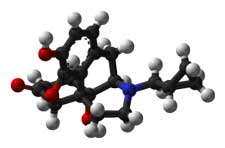 Low Dose Naltrexone
Low Dose Naltrexone
At first glance low dose Naltrexone (LDN) seems like a strange drug for people with chronic fatigue syndrome (ME/CFS) to use. Naltrexone blocks the opioid/endorphin receptors in the brain and is used primarily in battling alcoholism and to assist in rapid detoxification from narcotics. Over time Naltrexone reduces opiate/endorphin activity thus reducing the ‘kick’ people get from narcotics and alcohol.
Ironically LDN’s short term blockade of the endorphin receptors results in increased endorphin levels in the brain. This occurs because LDN’s blockage of these receptors tricks the brain into thinking endorphin levels are low causing it to compensate by increasing endorphin levels. Endorphins, which are known as ‘natural pain relievers’, are produced by the HPA axis during exercise, excitement, pain, sexual activity, meditation, acupuncture, massage therapy and by eating spicy foods and chocolate. (The “phin” in endorphin is a take off of morphine). “Runners high’ is believed produced by high endorphin levels in the brain after extended exercise.
Endorphins effect the immune system by enhancing natural killer cell response and reducing B-cell (antibody) activity and LDN’s effectiveness is being tested in several autoimmune diseases.
LDN appears to effect the functioning of the regulatory immune cells in the central nervous system called microglial cells. Upon activation by infection or cell damage micoglial cells produce pro-inflammatory cytokines, reactive oxygen species (free radicals) and nitric oxide. Microglial cells may be a key component of the ‘sickness response’ that produces fatigue, fluey feelings, pain, etc. when we come down with an infection. Some researchers believe that microglial cells may be chronically turned on in ME/CFS and fibromyalgia. LDN appears to block a receptor on the microglial cells thus inhibiting their activation.
Preliminary results also suggest LDN may be helpful in several autoimmune diseases such as multiple sclerosis and Crohn’s disease.
LDN Might Be Helpful in Chronic Fatigue Syndrome/Fibromyalgia Because..
it may be able to reregulate immune functioning and increase neurotransmitters called endorphins that may be low in the disorder.
Endorphins are released into the spinal cord by the pituitary gland and hypothalamus in the HPA axiz. Many studies have shown mild to moderate dysfunction of the HPA axis is present in chronic fatigue syndrome. The fact that beta-endorphin is made from the same substance (POMC) which is the precursor for ACTH, which some studies suggest is low in ME/CFS, suggests endorphin levels could be low in the disorder.
LDN’s ability to modulate natural killer cell activity upwards and reduce B-cell activity could also help to re-regulate the immune response in ME/CFS. It’s ability to reduce microglial functioning could reduce the fatigue and pain and other symptoms associated with the ‘sickness response’. A small 2009 study found significantly reduced sensitivity to pain after 8 weeks of LDN use in fibromyalgia.
Chronic Fatigue Syndrome (ME/CFS) Studies
None
Chronic Fatigue Syndrome (ME/CFS) Doctors Report
None
Chronic Fatigue Syndrome (ME/CFS) Patients Report
Check out a discussion on LDN and CFS o on the Phoenix Rising Forums
Side Effects
are usually reportedly minimal but can include priapism (prolonged erections), sleep dysfunction (at least in the beginning) and weight loss.
Others
LDN was described by one researchers as being ‘dirt cheap’. Some patients report that finding a good compounding pharmacy is important. LDN is generally taken at night to enhance the endorphin production occurring during sleep.
Resources
(This and all sections of the Phoenix Rising website are compiled by a layman. They are not a substitute for a physician and are for informational uses only. Please discuss any treatments in these pages with your physician.)
_________________________________________

